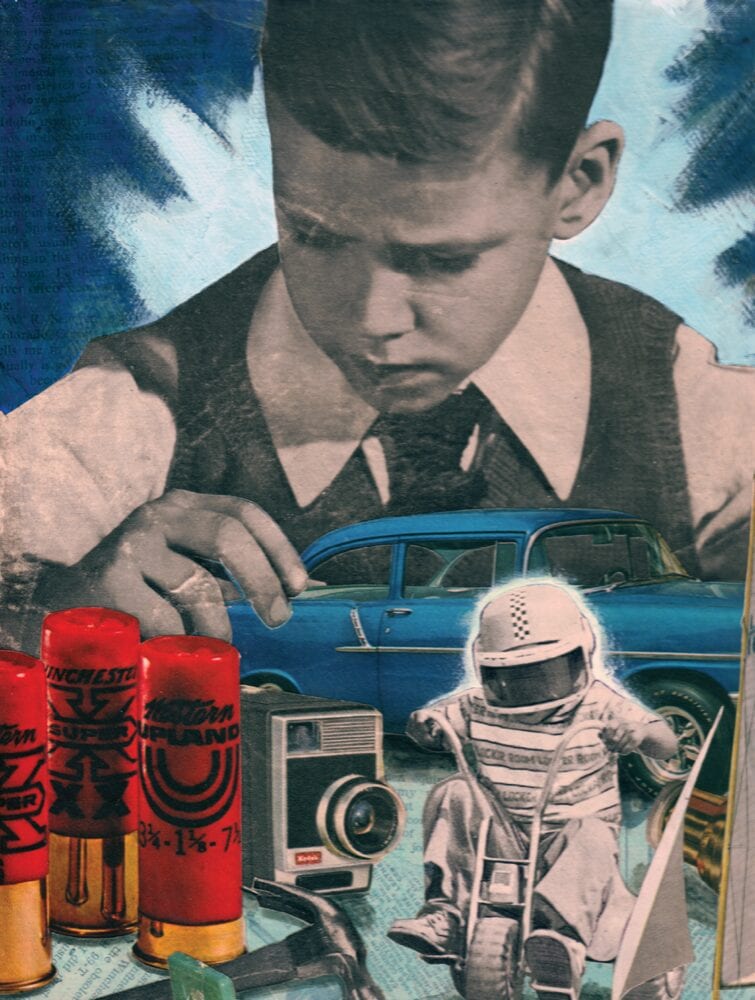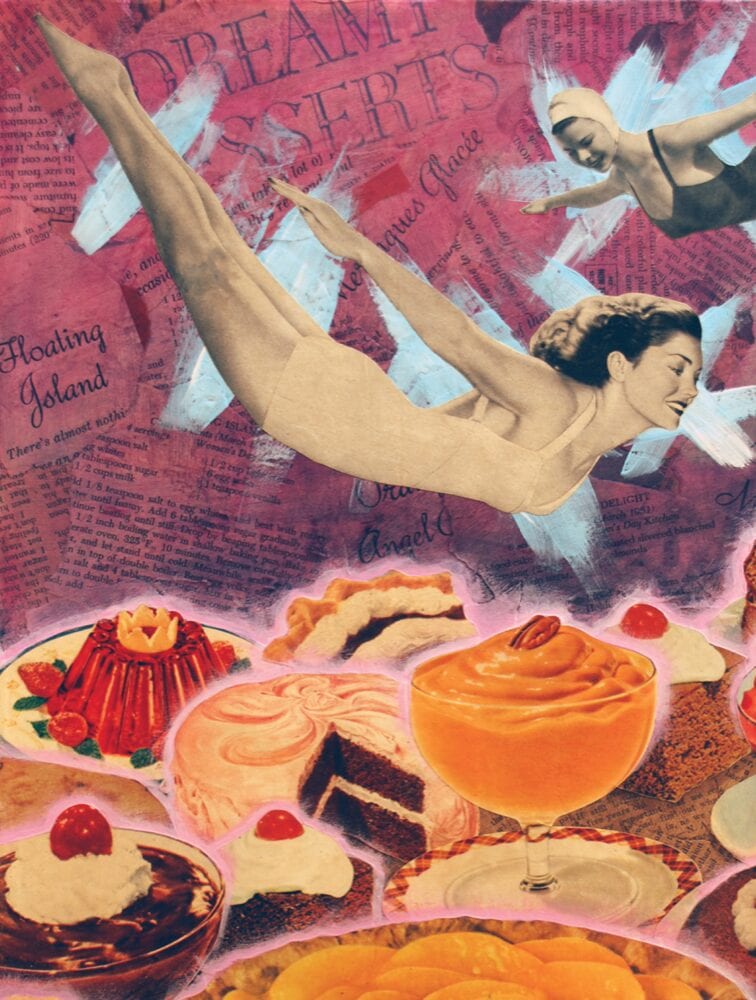TurningArtist spotlight on Ray Sell.
Installation Magazine: As a multi-media artist working with collage and painting, what source material do you tend to gravitate toward? Are there publications or advertisements from a certain decade that inspire you? Where do you find your source material?
Ray Sell: The majority of my imagery is from the 1940’s to 70’s. I find myself gravitating towards publications and advertisements from those eras because of the overly dramatic figures, a certain handmade quality (something about how photos were actually created is a darkroom and then hand-colored) and vivid primary colors. Since I started making and showing my collage work, friends and collectors have started unloading their old magazines on me, knowing I’ll put them to good use. I have found a lot of magazines at yard and tag sales, but when I’m looking for a specific type of magazine, I always check eBay.
When did you first begin working with collage?
I majored in graphic design in community college and also studied photography. Later, I transferred to the School of Visual Arts in New York where I majored in illustration. After school, I tried to find a way to combine all of these areas of interest. My work combines the meticulousness of graphic design with photographic composition and the narrative capabilities of illustration. I find the act of making collage to very liberating. I’ll layout a table with literally thousands of cutout images, and try to find interesting juxtapositions to create a narrative.
Your work often uses text.
The abundance of text seen in the background is meant to represent how media is all around us at all times, now that news and entertainment has become almost instant. I think that dynamic between chaotic text and meticulously placed figures and objects makes for an interesting picture.
What is your process like?
The most appealing aspect of collage is the evidence of the layering process because they create surface that can’t be achieved with just paint or a print. I don’t start adhering paper to canvas until I have a game plan; there are no do-overs when you’re dealing with one-of- a- kind image. All of my images are directly from the original publication, I don’t Xerox or scan and print. The works becomes an artifact when it employs the original image, an image printed decades ago.

The images are at once meticulous and ordered but also bombard the visual plane. How do you feel your compositions represent American culture?
All of my work is about different aspects of American culture and I typically focus on masculinity. Much of my work deals with male rites of a passage and masculine stereotypes: fathers passing down their views of the world, alcoholism, the male’s role as the provider, adolescence, and peer pressure. I always keep the work lighthearted, even if some of my pieces address more serious issues. I call them visual puns.
I noticed that in your biography you cited Howard Beale’s famous rant from the film Network, which poignantly satirizes and predicted the lunacy of American media. How have your views of American culture changed from the time you began your journey as an artist to the present?
Like everyone else I was much more naïve when I was younger when it came to the ways of the world. (For example I actually thought I could make a decent living as an artist.) I am a bit more cynical about American culture now, but I still can find the good and I still find humor.
How does your work address nostalgia?
I often get nostalgic. Sometimes I feel I was born in the wrong decade. If I didn’t have to use a computer for work I would probably never use one. That’s another reason I like collage: the only tools I need are a knife and a brush.

You often include images of little boys tinkering with their toys. Do you identify with these subjects?
The boys in my work represent innocence. They are typically being taught either by their fathers or by watching TV. I about the world in the same way. A child is like blank canvas and can turn out as either a masterpiece or a disaster.
Why do you think collage is still important in contemporary culture? What do you think it reveals? Does it express a message that other mediums can’t?
I use collage because I find it an effective way to create an image. Collage or photo montage is a unique medium in that it requires reusing and reinventing existing images. It allows the artist to give an image an entirely different meaning by either manipulating it, or just changing its environment. One can make current a piece art that is historically significant.
What has your experience been like working with TurningArt? With the gallery system shifting, do you feel that this new style of representation is more successful in reaching new collectors? Have you discovered any artists on TurningArt that have influenced or inspired your art practice?
My experience with TurningArt has been great. I’ve sold work, met new collectors, gained more exposure. It has also provided me an addition venue to send people who are interested in my work. This style of representation will absolutely attract new collectors; I can see how the gallery setting can be a bit intimidating. I don’t think websites like TurningArt will ever replace the gallery. Most work needs to be seen in person; the setting in which the art is viewed can change the look feel, and meaning of a piece. The curators at TurningArt do a great job choosing artists that have a cohesive style and collection of work. I browse through TurningArt and find a ton of great work that inspires me to get in the studio and get busy.

